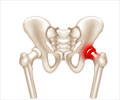According to a new study at Cincinnati Children's Hospital Medical Center, pediatricians now created a screening tool to determine whether children with chronic diseases like Crohn's
According to a new study at Cincinnati Children's Hospital Medical Center, pediatricians now created a screening tool to determine whether children with chronic diseases like Crohn's, juvenile arthritis and anorexia nervosa -- or those undergoing cancer treatment -- are at increased risk for bone mass deficiencies, fracture or osteoporosis as they get older.
There is a huge demand for this information among clinicians because in almost any chronic condition in children affecting growth, inflammation, or involving cancer survivors, they have problem bones,'' said Heidi Kalkwarf, PhD, associate professor of Community and General Pediatrics at Cincinnati Children's, and lead author of the research report. "The issue is you can't know there is a problem unless you know what is normal and part of the research focuses on identifying what is normal."The study focused on gathering standardized data about accumulation of bone mass during childhood -- a critical determinant of whether children are at elevated risk for fracture or osteoporosis, Dr. Kalkwarf said. The research findings will allow physicians to use standardized data on bone mass categorized by sex, age, and race -- and formatted similar to a growth chart -- as a screening tool to identify children with potential underlying problems in skeletal development.
In collecting their data, researchers conducted bone density scans on the spine, forearm, hip and whole body to establish reference data for multiple skeletal sites. This comprehensive evaluation of bone status will determine if certain conditions or treatments affect some skeletal sites differently from others. The research was funded by and conducted under the auspices of the National Institute for Child Health and Human Development (NICHD) of the National Institutes of Health. The research report is published in the June edition of the Journal of Clinical Endocrinology and Metabolism.
Prior to this study, available bone density reference data were not optimal for evaluating the status of children because sample sizes were too small and standardized protocols were not used for including and measuring patients, Dr. Kalkwarf noted. As well, the collection and analysis of previous data were inconsistent and did not factor in variables for age, sex and race -- all important reference points in evaluating the bone health of children.
"Before this data it was like comparing apples to oranges," Dr. Kalkwarf said. "Now, pediatricians can monitor children according to the chart we developed and determine if they are normal or if there's something that needs to be investigated further."
Cincinnati Children's was invited by the NICHD to participate in the national multi-institutional study, which used dual-energy x-ray absorptiometry (DXA) to measure bone mineral content (BMC) and density (BMD) in 1,500 healthy children between the ages of 6 and 17. The study is the first to include all criteria needed to serve as a pediatric reference database for normal bone density in children:
Advertisement
2.A well-characterized, healthy and ethnically diverse sample large enough to capture normal bone mass variability
3.Statistical analysis methods that adequately characterize age-related trends and value distribution at different ages
The study found that bone mass is still increasing at age 16 in girls and 17 in boys, underscoring the importance of maintaining healthy nutrition and lifestyle habits as teens approach adulthood and identifying children prone to bone deficiencies. Dr. Kalkwarf said most people continue to accumulate bone mass into their 20s, although this study did not evaluate patients beyond the age of 17.
Advertisement
Study participants were recruited between July 2002 and November 2003 at five centers in the United States: Cincinnati Children's; Children's Hospital of Los Angeles; Creighton University, Omaha, Neb.; Children's Hospital of Philadelphia. Data was collected from participants between August 2002 and December 2005. To help ensure consistency, all DXA scans were analyzed centrally by the DXA Core Laboratory at the University of California in San Francisco using software with specialized features for pediatric scans.
Kalkwarf said researchers plan to continue their work, seeking to advance their findings by analyzing a seven-year stream of data. This will allow growth charts to be extended up to 21 years of age in males and 20 years in females. One goal is to develop a way to determine, for example, if a 7-year-old child ranking in the 50th percentile for bone mass remains or falls behind that percentile by age 15, and whether he or she may be at risk for osteoporotic fracture later in life.
Cincinnati Children's Hospital Medical Center, one of the leading pediatric research institutions in the nation, is dedicated to changing the outcome for children throughout the world. Cincinnati Children's ranks second among all pediatric institutions in the United States in grants from the National Institutes of Health.
It has an established tradition of research excellence, with discoveries including the Sabin oral polio vaccine, the surfactant preparation that saves the lives of thousands of premature infants each year, and a rotavirus vaccine that saves the lives of hundreds of thousands of infants around the world each year. Current strategic directions include the translation of basic laboratory research into the development of novel therapeutics for the treatment of disease, and furthering the development of personalized and predictive medicine.
Source-Eurekalert
LIN/M







